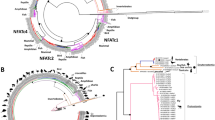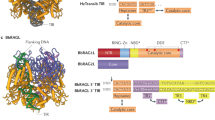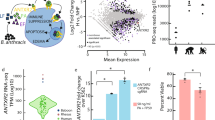Abstract
We have traced the rapid molecular evolution of eosinophil–derived neurotoxin (EDN) and eosinophil cationic protein (ECP), two host defense proteins that are members of the mammalian ribonuclease gene family. The EDN/ECP gene pair arose from a recent duplication event that occurred after the divergence of New World and Old World monkeys. Since duplication, the genes encoding EDN and ECP have accumulated non–silent mutations at rates exceeding those of all other functional coding sequences studied in primates, while retaining both the structural and catalytic components required for ribonuclease activity. These results suggest that both EDN and ECP may be responding to unusual evolutionary constraints, which has prompted a reexamination of their physiologic function.
This is a preview of subscription content, access via your institution
Access options
Subscribe to this journal
Receive 12 print issues and online access
$209.00 per year
only $17.42 per issue
Buy this article
- Purchase on Springer Link
- Instant access to full article PDF
Prices may be subject to local taxes which are calculated during checkout
Similar content being viewed by others
References
Spry, C.J.F. Eosinophils: a comprehensive reviewandguide to thescientific and medical literature (Oxford University Press, Oxford, 1988).
Makino, S. & Fukuda, T. (eds). Eosinophils: biological and clinical aspects (CRC Press, FL, 1993).
Gleich, G.J. et al. Biochemical and functional similarities between human eosinophil-derived neurotoxin and eosinophil cationic protein: homology with ribonuclease. Proc. natn. Acad. Sci. U.S.A. 83, 3146–3150 (1986).
Slifman, N.R., Loegering, D.A., McKean, D.J. & Gleich, G.J. Ribonuclease activity associated with human eosinophil-derived neurotoxin and eosinophil cationic protein. J. Immunol. 137, 2913–2917 (1986).
Gullberg, U., Widegren, B., Arivason, U., Egesten, A. & Olsson, I. The cytotoxic eosinophil cationic protein (ECP) has ribonuclease activity. Biochem. Biophys. Res. Commun. 139, 1239–1242 (1986).
Rosenberg, H.F., Tenen, D.G. & Ackerman, S.J. Molecular cloning of the human eosinophil-derived neurotoxin: a member of the ribonuclease gene family. Proc. natn. Acad. Sci. U.S.A. 86, 4460–4464 (1989).
Rosenberg, H.F., Ackerman, S.J. & Tenen, D.G. Human eosinophil cationic protein. Molecular cloning of a cytotoxin and helminthotoxin with ribonuclease activity. J. exp. Med. 170, 163–170 (1989).
Barker, R.L. et al. Eosinophil cationic protein cDNA. Comparison with other toxic cationic proteins and ribonucleases. J. Immunol. 143, 952–955 (1989).
Hamann, K.J., Barker, R.L., Loegering, D.A. & Gleich, G.J. Seqeucne of human eosinophil-derived neurotoxin cDNA: identity of deduced amino acid sequence with human nonsecretory ribonucleases. Gene 83, 161–167 (1989).
Hamann, K.J. et al. Structure and chromosome localization of the human eosinophil-derived neurotoxin and eosinophil cationic protein genes: evidence for intronless coding sequences in the ribonuclease gene family. Genomics 7, 535–546 (1990).
Samuelson, L.C. et al. Isolation of the murine ribonuclease gene rib-1: structure and tissue specific expression in pancreas and parotid gland. Nucl. Acids Res. 19, 6935–6941 (1991).
Kurachi, K., Davie, E.W., Strydom, D.J., Riordan, J.F. & Vallee, B.L. Sequence of the cDNA and gene for angiogenin, a human angiogenesis factor. Biochemistry 24, 5494–5499 (1985).
Haugg, M. & Schein, C.H. The DNA sequences of the human and hamster secretory ribonucleases determined with the polymerase chain reaction (PCR). Nucl. Acids Res. 20, 612 (1992).
MacDonald, R.J., Stary, S.J. & Swift, G.H. Rat pancreatic ribonuclease messenger RNA. The nucleotide sequence of the entire mRNA and the derived amino acid sequence of the pre-enzyme. J. biol. Chem. 251, 14582–14585 (1982).
Blackburn, P. & Moore, S. in The Enzymes, (ed. Boyer, P.) 317–358 (Academic Press, New York, 1982).
Nei, M. & Gojobori, T. Simple methods for estimating the numbers of synonymous and nonsynonymous nucleotide substitutions. Molec. biol. Evol. 3, 418–426 (1986).
Nei, M. Molecular Evolutionary Genetics (Columbia University Press, New York, 1987).
Li, H.-H. & Graur, D. Fundamentals of molecular evolution.(SinauerAssociates, Sunderland, 1991).
Sibley, C.G. & Ahlquist, J.E. The phytogeny of the hominoid primates as indicated by DNA-DNA hybridization. J.molec. Evol. 20, 2–15 (1984).
Whitfield, L.S., Lovell-Badge, R. & Goodfellow, P.N. Rapid sequence evolution of the mammalian sex-determining gene SRY. Nature 364, 713–715 (1993).
Retief, J.D. et al. Evolution of protamine P1 genes in primates. J. molec. Evol. (1993).
Retief, J.D. & Dixon, G.H. Evolution of pro-protamine P2 genes in primates. Eur. J. Biochem. 214, 609–615 (1993).
Li, W.H., Wu, C.-I. & Luo, C.-C. New method for estimating synonymous and nonsynonymous rates of nucleotide stubstitution considering the relative likelihood of nucleotide and codon changes. Molec. biol. Evol. 2, 150–174 (1985).
Sorrentino, S. et al. Eosinophil-derived neurotoxin and human liver ribonuclease. Identity of structure and linkage of neurotoxicity to nuclease activity. J. biol. Chem. 267, 14589–14865 (1992).
Newton, D.L. et al. Toxicity of an anti-tumor ribonuclease to Purkinje neurons. J. Neurosci. 14, 538–544. (1994).
Molina, H.A., Kierszenbaum, F., Hamann, K.J. & Gleich, G.J. Toxic effects produced or mediated by human eosinophil granule components on Trypanosoma cruzi. Am. Trop. med. Hyg. 38, 327–324 (1988).
Rosenberg, H.F. Recombinant eosinophil cationic protein (ECP): ribonuclease activity is not essential for cytotoxicity. J. biol. Chem. 270, 7876–7881 (1995).
Ardelt, W., Mikulski, S.M. & Shogen, K. Amino acid sequence of an anti-tumor protein from Ranapipiens oocytes and early embryos Homology to pancreatic ribonucleases. J. biol. Chem. 266, 245–251 (1991).
Wu, Y., Mikulski, S.M., Ardelt, W., Rybak, S.M. & Youle, R.J. A cytotoxic ribonuclease.Study of the mechanism of onconase cytotoxicity. J. biol. Chem. 268, 10686–10693 (1993).
Nitta, K. et al. Inhibition of cell proliferation by Rana catesbeiana and Rana japonica lectins belonging to the ribonuclease superfamily. Cancer Res. 54, 920–927 (1994).
Di Donato, A., Cafaro, V. & D'Alessio, G. Ribonuclease A can be transformed into a dimeric ribonuclase with antitumor activity. J. biol. Chem. 269, 17394–17396 (1994).
Laccetti, P. et al. Seminal ribonuclease inhibits tumor growth and reduced the metastatic potential of Lewis lung carcinoma. Cancer Res. 54, 4253–4256 (1994).
Murphy, P.M. Molecular mimicry and the generation of host defense protein diversity. Cell 72, 823–826 (1993).
Jermann, T.M., Opitz, J.G., Stackhouse, J. & Benner, S.A. Reconstructing the evolutionary history of the artiodactyl ribonuclease superfamily. Nature 374, 57–59 (1995).
Author information
Authors and Affiliations
Rights and permissions
About this article
Cite this article
Rosenberg, H., Dyer, K., Tiffany, H. et al. Rapid evolution of a unique family of primate ribonuclease genes. Nat Genet 10, 219–223 (1995). https://doi.org/10.1038/ng0695-219
Received:
Accepted:
Issue Date:
DOI: https://doi.org/10.1038/ng0695-219
This article is cited by
-
Ribonucleases 6 and 7 have antimicrobial function in the human and murine urinary tract
Kidney International (2015)
-
Genetic diversity of human RNase 8
BMC Genomics (2012)
-
Analysing the eosinophil cationic protein - a clue to the function of the eosinophil granulocyte
Respiratory Research (2011)
-
Identification of polymorphisms in the RNase3 gene and the association with allergic rhinitis
European Archives of Oto-Rhino-Laryngology (2010)
-
RNase 1 genes from the family Sciuridae define a novel rodent ribonuclease cluster
Mammalian Genome (2009)



